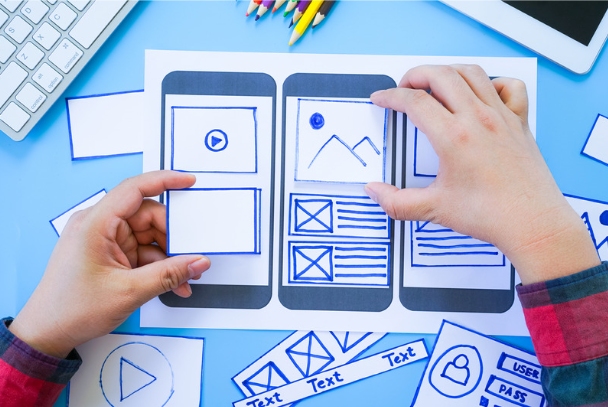Last week, two of our team members at ASTOUNDZ jumped into the grind at the State of Search SEO conference in Grapevine, Texas.

Blog Category pages subscription form.

Mobile First Design represents a modern development approach that starts with mobile devices as the primary platform. Developers first create intuitive experiences for smartphones, then gradually enhance the design for larger screens like tablets and computers. This method ensures that core features work flawlessly on mobile devices – where most users first encounter websites today. By focusing on mobile optimization from the start, organizations deliver better experiences to their increasingly smartphone-centric audience while maintaining flexibility for all screen sizes.

Last week, two of our team members at ASTOUNDZ jumped into the grind at the State of Search SEO conference in Grapevine, Texas.

If your keyword rankings or SEMrush reports suddenly dropped in September, you weren’t alone.

In today's digital world, it's more important than ever for businesses to stand out online. One of the best ways to do this is through paid search. But what exactly does that mean? Paid search is when businesses pay for their ads to appear at the top or bottom of...

AI is changing the way brands connect with people. In digital marketing, AI helps businesses make smarter decisions by understanding customer behavior, creating personalized content, and automating tasks. Let's take a closer look at how AI is shaping the future of...

Website development is changing fast! New technologies are popping up all the time, and they're making websites more powerful, interactive, and user-friendly. In this article, we're going to explore the cool emerging technologies that are shaping web development today...

In today's digital world, the way we access websites has changed drastically. People are spending more time on their smartphones than ever before, and businesses need to keep up with this shift. Mobile-first design is the solution. This approach focuses on creating...

Social media ads are a game-changer for businesses today, offering a world of potential. With billions of people using social media every day, platforms like Facebook, Instagram, TikTok, and LinkedIn are more than places to post pictures and updates—they're powerful...

In today's fast-paced digital world, online shopping is more popular than ever. As e-commerce continues to grow, new technologies are shaping the way we search for products and make purchases. One of the most exciting developments is voice search optimization. More...

In the ever-evolving world of digital marketing, Search Engine Optimization (SEO) continues to play a pivotal role in driving online visibility, traffic, and conversions. As we move into 2025, SEO remains at the core of online marketing strategies, but its landscape...

In today's fast-paced digital world, businesses need creative and effective ways to get noticed. With so much competition online, it can be hard for a brand to stand out. This is where display advertising comes in. If you're looking to reach a wider audience, digital...

The shift toward prioritizing mobile interfaces emerged during the early 2010s, coinciding with the surge in smartphone browsing. Previously, designers created websites with desktop screens in mind, treating mobile versions as afterthoughts – often resulting in compromised user experiences on smaller devices. Industry pioneers recognized this disconnect and championed a new approach, beginning with mobile layouts as the foundation. This revolutionary perspective transformed digital design practices, establishing small-screen optimization as the starting point rather than an adaptation. In today’s digital landscape, this approach has become fundamental, reflecting the reality that most people first experience websites through their mobile devices.
Mobile First Design: A design strategy that starts with smartphones in mind. Instead of shrinking desktop websites, designers build from the small screen up, ensuring the core experience works perfectly on mobile devices before adding enhancements for larger screens.
Responsive Design: A flexible design approach where websites automatically adjust to fit any screen size. Whether viewed on a phone, desktop, or tablet, the layout shifts and resizes to provide the best possible viewing experience.
CSS Media Queries: Smart styling rules that detect what kind of device is being used. These rules help websites adapt their appearance based on screen size, device type, and even how the device is being held.
Viewport Meta Tag: A crucial website instruction that tells mobile devices how to adjust the page’s size and scaling. It’s like giving your website a set of guidelines for how to present itself on different screens.
Touch-Friendly Navigation: Design that makes websites easy to use with fingers rather than mouse pointers. This includes larger buttons, comfortable spacing, and intuitive touch gestures that feel natural on mobile devices.
Progressive Enhancement: A layered approach to website building that starts with a solid foundation of essential features and then adds more sophisticated functionality for devices that can support it.
Mobile-First Indexing: Google’s approach to ranking websites based on their mobile version first. This reflects how most people browse the internet today and encourages better mobile experiences.
Breakpoints: Specific screen sizes where a website’s layout changes to better fit the display. Think of them as transition points where content reorganizes itself for optimal viewing.
Touch Gestures: The various ways users interact with touchscreens – swiping, tapping, pinching, and more. These natural movements have become second nature in mobile navigation.
Scalable Vector Graphics (SVG): Graphics that stay sharp at any size, perfect for logos and icons that need to look crisp on both tiny phones and large desktop screens.
Minimalist Design: A clean, focused approach that eliminates unnecessary elements. This helps mobile users find what they need without getting lost in clutter.
Responsive Images: Pictures that automatically adjust their size and quality based on the device viewing them. This ensures fast loading while maintaining visual quality.
Hamburger Menu: The three-line icon that’s become a universal shorthand for “menu” on mobile devices. It saves space while keeping navigation options accessible.
Viewport: The visible area of a website on a device’s screen. It’s like a window through which users view your content.
Pixel Density: How many pixels are packed into each inch of a screen. Higher density means sharper images and text on modern mobile devices.
Mobile Optimization: The ongoing process of improving how a website performs on mobile devices, focusing on speed, usability, and user satisfaction.
Adaptive Design: Creating specific versions of a website for different device sizes rather than using one flexible layout. Each version is optimized for its target screen size.
Lazy Loading: A smart loading technique that only downloads images and content as users scroll down the page, saving data and improving load times.
Cross-Device Testing: Checking how a website performs across different browsers and devices to ensure a consistent experience for all users.
Font Size Adjustment: Make sure text is readable across all screens by automatically adjusting its size based on the device and viewing distance.
User-Centered Design: Creating websites with real users in mind, focusing on their needs, preferences, and behaviors rather than just technical requirements.
Fast Mobile Pages (AMP): A specialized format for creating super-fast loading mobile web pages, particularly useful for news and content-heavy sites.
Mobile Navigation: The system of menus, buttons, and links that helps users find their way around a mobile website efficiently.
Device Emulation: Tools that let designers and developers test how their websites look on different devices without having physical access to them.
Mobile Page Speed: How quickly a website loads on mobile devices – a crucial factor for keeping users engaged and satisfied.
Viewport Width (vw): A measurement unit that’s relative to the screen’s width, helping create layouts that scale proportionally across devices.
Mobile Layout: The arrangement of content specifically designed for mobile screens, typically in a single column for easy scrolling.
Gesture Control: Using touch movements to interact with website elements, like swiping through a gallery or pulling to refresh content.
Mobile Accessibility: Ensuring websites are usable by everyone, including people with disabilities, on mobile devices.
Wireframe: A basic sketch of a website’s layout that helps plan content placement and user flow before adding visual design elements.
Click-Through Rate (CTR): The percentage of users who tap on links or buttons, helping measure how engaging and effective a mobile design is.
Frictionless Navigation: Making it as easy as possible for users to move through a website without obstacles or confusion.
One-Handed Navigation: Designing interfaces that can be comfortably used with just one thumb, acknowledging how most people hold their phones.
Thumb Zone: The area of a screen that’s easy to reach with your thumb when holding a phone. Important buttons should live in this zone.
Mobile Analytics: Data about how users interact with your mobile website, helping identify what works and what needs improvement.
Hierarchy of Content: Organizing information by importance, ensuring the most crucial elements are easily accessible on mobile screens.
Fluid Layout: A design that smoothly adjusts its proportions as screen sizes change, rather than jumping between fixed layouts.
Iconography: Using universal symbols and icons to save space and communicate clearly without words.
Touch Targets: Buttons and interactive elements are sized and spaced appropriately for finger taps, reducing errors and frustration.
Device Orientation: How a website adapts when users switch between holding their device vertically or horizontally.
Mobile Design Patterns: Common solutions to mobile design challenges that users have come to expect and understand.
Responsive Typography: Text that automatically adjusts its size and spacing to remain readable across different screen sizes.
Progressive Web App (PWA): Websites that function like mobile apps, offering features like push notifications and offline apps.
Tap Target: Any element users can interact with by touching, sized appropriately for human fingers.
Viewport Units: Measurements that automatically scale based on the screen size, helping create proportional layouts.
Fast Clicks: Making buttons and links respond instantly to taps, eliminating annoying delays on mobile devices.
Mobile Breakpoints: Screen sizes where the layout needs to change to maintain a good user experience.
Skeleton Screens: Placeholder content that shows while a page loads, helping users understand what’s coming.
Scroll Hijacking: Taking control of how a page scrolls, though this should be used carefully to avoid frustrating users.
Pinch-to-Zoom: Letting users zoom in and out by pinching the screen, which is useful for detailed content.
Adaptive Images: Pictures that load at different qualities depending on the device and connection speed.
Mobile Content Strategy: Planning what content to show and how to present it effectively on mobile devices.
Microinteractions: Small, satisfying responses to user actions, like subtle animations when tapping buttons.
Viewport Scaling: Controlling how content scales to fit different screen sizes while maintaining readability.
Mobile Page Speed Optimization: Techniques to make websites load faster on mobile devices are crucial for keeping users engaged.
User Flow: The path users take through a website to accomplish their goals, designed to be smooth and intuitive.
Adaptive Navigation: Menus that change their style and layout based on the device being used.
Mobile Sitemap: A guide showing how pages are organized and optimized for mobile search engines.
Swipeable Content: Elements users can navigate by swiping left or right, which is common in image galleries and carousels.
One-Column Layout: Arranging content in a single vertical column for easy mobile reading and scrolling.
Fast Mobile Navigation: Quick and easy ways for users to find what they’re looking for on mobile devices.
UX Design for Mobile: Creating enjoyable and efficient experiences specifically for mobile users.
Fold: The part of a webpage that is visible without scrolling on the first load.
Scroll Depth: How far users scroll down a page, helping understand engagement levels.
Mobile Viewport: The visible area of a website on a mobile screen.
Swipe Navigation: Using left and right swipes to move between pages or sections of content.